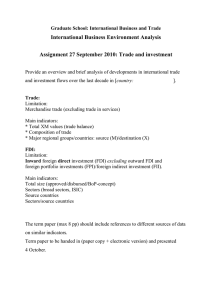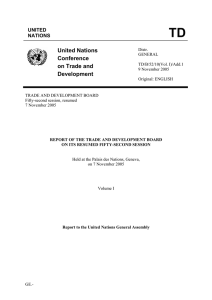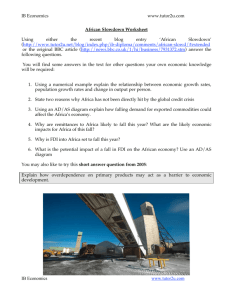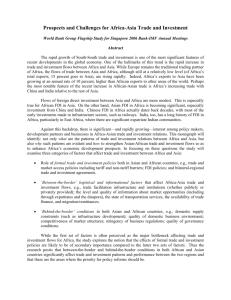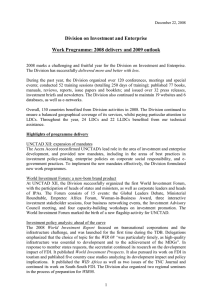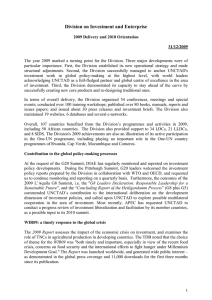January 30, 2012
advertisement
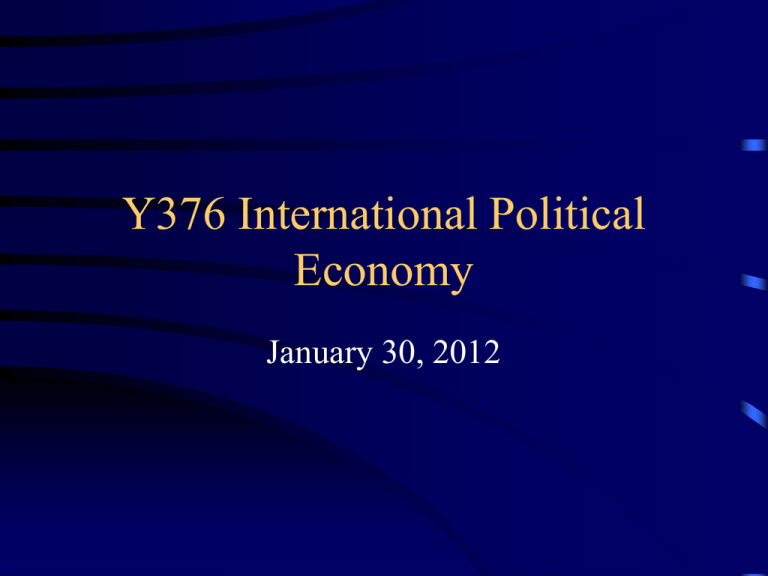
Y376 International Political Economy January 30, 2012 Types of Regional Integration • • • • Regional cooperation agreements Free trade areas Customs unions Common markets Increasing difficulty Examples • European Union (EU) • North American Free Trade Agreement (NAFTA) • Central American Free Trade Agreement (CAFTA) • Southern African Development Community (SADC) Table 7-3. Important Regional Trade Agreements Region Europe North America Latin America and the Caribbean Africa Asia Middle East Name Acronym European Union EU European Free Trade Association EFTA North American Free Trade Agreement NAFTA Latin American Integration Association LAIA Andean Common Market ANCOM Central American Common Market CACM Southern Cone Common Market Mercosur Caribbean Community CARICOM Arab Maghreb Union UMA Economic Community of Central African States ECCAS Central African Customs and Economic Union CACEU Economic Community of West African States ECOWAS West African Economic Community CEAO Southern African Development Community SADC Association of South-East Asian Nations ASEAN Asia Pacific Economic Cooperation APEC Economic Cooperation Organization ECO South Asian Association for Regional Cooperation SAARC Gulf Cooperation Council GCC The European Union • 1957 Treaty of Rome created the European Economic Community (6 members) • Current number of members = 27 • Creation of the Unified Market under the Maastricht Treaty of 1992 • Creation of the Euro in 1999 • Passports abolished under the Schengen agreement Members of the EU 1952 Belgium, France, Germany, Italy, Luxembourg, Netherlands 1973 Denmark, Ireland, United Kingdom 1981 Greece 1986 Portugal, Spain 1995 Austria, Finland, Sweden 2004 Cyprus, Czech Republic, Estonia, Hungary, Latvia, Lithuania, Malta, Poland, Slovakia, Slovenia 2007 Bulgaria, Romania Euro Zone Currency Union Funny video Trade Creation vs. Trade Diversion • How compatible are regional and multilateral trade regimes? • Economists study whether the regional arrangement creates or diverts trade • If the agreement simply diverts trade from extraregional countries to intraregional trading partners, then it is trade diverting. Fortress Europe vs. Fortress North America • Consider the case of European antitrust enforcement (Does it favor EU firms against US firms?) • Consider the NAFTA regional content rules for the auto industry (Do they discriminate against Japan and Europe?) Video (humorous) on the origins of NAFTA Why Hasn’t Regional Integration Been Successful Outside Europe? • Europe integrated mostly industrialized, wealthy countries. • The EU insists that members must have democratic governments. • Most other regions have considerably wider variations among potential members in size, wealth, degree of industrialization, and political systems (e.g. NAFTA). Multinational Corporations (MNCs) A multinational corporation is “an enterprise that engages in foreign direct investment (FDI) and that owns or controls value-added activities in more than one country. Synonyms: transnational corporation (TNC), multinational enterprise (MNE), transnational enterprise (TNE) The Transnationality of MNCs • Increases with: – number of countries in which it has subsidiaries or affiliate firms – number of countries in which the firm has operations of various sorts – foreign assets, revenues, employees over total – proportion of foreign employees, managers, stockholders UNCTAD’s Transnationality Index (TNI) by Industry, 2005 • Index based on three indicators: – Foreign assets/total assets – Foreign sales/total sales – Foreign employment/tota l employment Example: IBM “IBM operates in 170 countries, with about 65 percent of our employees outside the U.S., including 30 percent in Asia Pacific. Non-U.S. operations generate about 60 percent of IBM’s revenue. IBM’s research and software development have long been globally integrated. The company’s R&D system assigns work among our 20,000-plus software developers in 61 labs in 15 countries, and 3,000 scientists and technologists in IBM Research centers in the U.S., China, Israel, Switzerland, Japan and India, based on areas of unique expertise.” Source: IBM Annual Report 2006 Example: Samsung (Korea) • Total revenue = $158 billion in 2006 • The company employs approximately 138,000 people in 124 offices in 56 countries. • Samsung Electronics is a leading producer of digital TVs, memory chips, mobile phones and LCDs. Samsung is not as globally organized As IBM. Hierarchy of MNC Activities • Sales or marketing office • Simply assembly plants (screwdriver plants) • Full-scale manufacturing (final products and components manufactured abroad) • R&D operations abroad The OLI Model of Foreign Direct Investment • Ownership • Location • Internalization Market power that derives from ownership of special knowledge Advantages of a particular foreign location Firm must prefer FDI to other ways of conducting foreign business (e.g., exports, licensing) Source: Various works by John Dunning. Product-Cycle Theory Growth Sales Time Source: Raymond Vernon. Decline Maturity Definition of Foreign Direct Investment An investment made to acquire control over enterprises operating outside of the economy of the investor. Control means owning 10% or more of the ordinary shares or voting power of a firm or its equivalent; lower ownership shares are known as portfolio investment. Two Main Reasons to Invest Abroad via FDI • To gain access to local markets (horizontal FDI) • To gain access to low-cost inputs (vertical FDI) Most North-North FDI is horizontal; most North-South FDI is vertical. Greenfield vs. Mergers and Acquisitions • Two main methods of acquiring control of foreign assets: – Greenfield investments – Mergers and Acquisitions Daimler-Benz purchase of Chrysler The Role of Mergers and Acquisitions Outflows of FDI from Developed and Developing Nations, in Billions of Current Dollars, 1970-2010 $1,600 $1,400 Developing Developed $1,200 $1,000 $800 $600 $400 $200 $0 1970 1975 1980 1985 1990 1995 2000 2005 Source: United Nations Conference on Trade and Development, World Investment Report. Inflows of FDI into Developed and Developing Nations, in Billions of Current Dollars, 1970-2010 $1,600 $1,400 Developing Developed $1,200 $1,000 $800 $600 $400 $200 $0 1970 1975 1980 1985 1990 1995 2000 2005 Source: United Nations Conference on Trade and Development, World Investment Report. Figure 4-1. Outward Stock of Direct Foreign Investment in Billions of Dollars, 1960-2006 Sources: UNCTC, Transnational Corporations in World Development (New York: UN, 1988); UNCTAD, World Investment Report (Geneva: UNCTAD, 1999 and 2007). Figure 4-5. Inflows of FDI into the Big Five Industrialized Countries, in Billions of Current Dollars, 1965-2006 Source: World Bank, World Data 1994 CD-ROM (Washington, D.C.: World Bank, 1994); UNCTAD, World Investment Report (Geneva: UNCTAD, 2007). Figure 4-7. FDI Inflows into Developing and Transition Economies by Region, in Billions of Dollars, 1970-2006 Source: UNCTAD, World Investment Report 2007 (Geneva: UNCTAD, 2007). Number of MNCS from Developed and Developing Economies Key Facts • FDI flows are increasing more rapidly than trade flows • Most FDI flows, like trade flows, are from rich countries to other rich countries • An increasing amount of FDI is going to a small number of developing countries • There are increasing numbers of MNCs headquartered in developing countries How the US-Japan Trade Dispute in Autos Led to Greater FDI Flows from Japan to US • After the oil price increases of 1973, US consumers bought larger number of fuelefficient vehicles (VWs, Toyotas, etc.) • Auto industry accused Japan of dumping autos on US markets • Carter Administration negotiated a Voluntary Restraint Agreement (VRA) with Japan on autos Exports vs. Local Production of Automobiles in the United States by Japanese Firms, 19801990, in Thousands of Vehicles Source: Japan Automobile Manufacturers Association.
